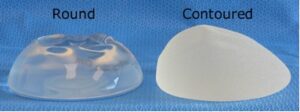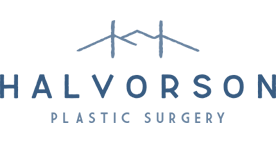DO SHAPED IMPLANTS MAKE A DIFFERENCE IN
Some colleagues attended the Atlanta Breast Symposium, one of the most highly regarded conferences on plastic surgery of the breast, and told me an interesting story. During one of the sessions, the crowd was shown photographs of women who had breast augmentation using a round or shaped (aka “teardrop” or “anatomic”) implant. Surgeons were asked to submit their guess as to which type of implant was used. The result was a great surprise. Plastic surgeons, who take pride in their ability to assess augmented breasts, could not tell the difference! Since that time, at least two studies using far more rigorous methodology have been published in major plastic surgery journals confirming the fact that experienced observers cannot tell the difference between shaped and round implants in most breast augmentations.
Should we assume that anatomic implants have no role in breast augmentation? If you’ve spent some time looking through my website, I hope you’ll see that I don’t believe in blanket statements regarding patient care in plastic surgery. Just because a study finds that an intervention makes no difference in 100 patients does not mean that it won’t make a difference for an individual patient. Although I generally do not use anatomic implants for breast augmentation surgery, there are certain patients in which they may offer an advantage. The important thing is to realize that there are advantages and disadvantages to each type of implant, so being happy with the implants you choose is more about making an informed decision that is right for you than it is about the specific implant.
Shaped implants must be textured. The rough surface allows the implant to stick to the surrounding tissues like Velcro, so it does not rotate. If a shaped implant had a smooth surface, it would rotate and the breast could look upside down one day, sideways the other, etc. In the last few years we have learned that textured implants can, in very rare instances, lead to a form of lymphoma around the implant (breast implant associated anaplastic large cell lymphoma, or BIA-ALCL). The more aggressive the texturing, the lower the risk of rotation but the higher the risk of BIA-ALCL. This is another reason I generally do not use textured implants. My patients don’t like worrying about BIA-ALCL, even if it is rare.

photo from: www.mybreastaugmentation.info
So – when is a textured shaped implant appropriate for augmentation? For a woman with very small breasts who wants a fairly large augmentation but wants to look as natural as possible, I do think an anatomic implant makes a difference. Most patients have a fair amount of breast tissue on top of the implants, and this is why it’s hard to tell the difference between a shaped and round implant. However, if the implant comprises 80-90% of your overall breast volume, then I do believe the shaped implant will result in a more natural appearance. These patients have to accept the risk of implant rotation (1-2%) and the remote risk of BIA-ALCL (1 in ~30,000 for Mentor implants), but it is something to consider. If a patient wants to pursue this (which is rare), I recommend using a Mentor implant, which has the least aggressive texturing. The risk of implant rotation may be a little higher, but the risk of BIA-ALCL is much lower.
Halvorson Plastic Surgery, Asheville
5 Livingston Street, Asheville, NC 28801
Monday – Friday 8:30 a.m. – 5 p.m.
COPYRIGHT HALVORSON PLASTIC SURGERY. ALL RIGHTS RESERVED.


